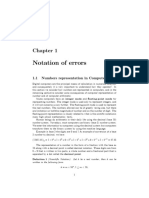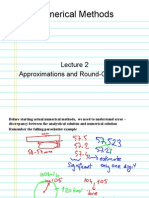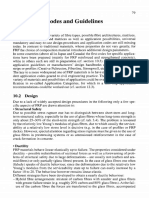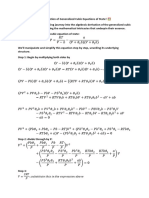Introduction To Numerical Methodes
Uploaded by
Miljan TrivicIntroduction To Numerical Methodes
Uploaded by
Miljan TrivicContents
Numerical Methods
Introduction to
30.1 Rounding Error and Conditioning 2
30.2 Gaussian Elimination 12
30.3 LU Decomposition 21
30.4 Matrix Norms 34
30.5 Iterative Methods for Systems of Equations 46
Learning
In this Workbook you will learn about some of the issues involved with using
a computer to carry out numerical calculations for engineering problems.
For example, the effect of rounding error will be discussed.
Most of this Workbook will consider methods for solving systems of equations.
In particular you will see how methods can be adapted so that rounding error
becomes less of a problem.
outcomes
Rounding Error and
Conditioning
_
`
30.1
Introduction
In this rst Section concerning numerical methods we will discuss some of the issues involved with
doing arithmetic on a computer. This is an important aspect of engineering. Numbers cannot,
in general, be represented exactly, they are typically stored to a certain number of signicant
gures. The associated rounding error and its accumulation are important issues which need to
be appreciated if we are to trust computational output.
We will also look at ill-conditioned problems which can have an unfortunate eect on rounding error.
_
`
Prerequisites
Before starting this Section you should . . .
recall the formula for solving quadratic
equations
_
Learning Outcomes
On completion you should be able to . . .
round real numbers and know what the
associated rounding error is
understand how rounding error can grow in
calculations
explain what constitutes an ill-conditioned
problem
2 HELM (2005):
Workbook 30: Introduction to Numerical Methods
1. Numerical methods
Many mathematical problems which arise in the modelling of engineering situations are too dicult,
or too lengthy, to tackle by hand. Instead it is often good enough to resort to an approximation given
by a computer. Indeed, the process of modelling a real world situation with a piece of mathematics
will involve some approximation, so it may make things no worse to seek an approximate solution of
the theoretical problem.
Evidently there are certain issues here. Computers do not know what a function is, or a vector,
or an integral, or a polynomial. Loosely speaking, all computers can do is remember long lists of
numbers and then process them (very quickly!). Mathematical concepts must be posed as something
numerical if a computer is to be given a chance to help. For this reason a topic known as numerical
analysis has grown in recent decades which is devoted to the study of how to get a machine to address
a mathematical problem.
Key Point 1
Numerical methods are methods devised to solve mathematical problems on a computer.
2. Rounding
In general, a computer is unable to store every decimal place of a real number. Real numbers are
rounded. To round a number to n signicant gures we look at the (n + 1)
th
digit in the decimal
expansion of the number.
If the (n + 1)
th
digit is 0, 1, 2, 3 or 4 then we round down: that is, we simply chop to n
places. (In other words we neglect the (n + 1)
th
digit and any digits to its right.)
If the (n + 1)
th
digit is 5, 6, 7, 8 or 9 then we round up: we add 1 to the n
th
decimal place
and then chop to n places.
For example
1
3
= 0.3333 rounded to 4 signicant gures,
8
3
= 2.66667 rounded to 6 signicant gures,
= 3.142 rounded to 4 signicant gures.
An alternative way of stating the above is as follows
HELM (2005):
Section 30.1: Rounding Error and Conditioning
3
1
3
= 0.3333 rounded to 4 decimal places,
8
3
= 2.66667 rounded to 5 decimal places,
= 3.142 rounded to 3 decimal places.
Sometimes the phrases signicant gures and decimal places are abbreviated as s.f. and d.p.
respectively.
Example 1
Write down each of these numbers rounding them to 4 decimal places:
0.12345, 0.44444, 0.5555555, 0.000127351, 0.000005
Solution
0.1235, 0.4444, 0.5556, 0.0001, 0.0000
Example 2
Write down each of these numbers, rounding them to 4 signicant gures:
0.12345, 0.44444, 0.5555555, 0.000127351, 25679
Solution
0.1235, 0.4444, 0.5556, 0.0001274, 25680
Task
Write down each of these numbers, rounding them to 3 decimal places:
0.87264, 0.1543, 0.889412, 0.5555
Your solution
Answer
0.873, 0.154, 0.889, 0.556
4 HELM (2005):
Workbook 30: Introduction to Numerical Methods
Rounding error
Clearly, rounding a number introduces an error. Suppose we know that some quantity x is such that
x = 0.762143 6 d.p.
Based on what we know about the rounding process we can deduce that
x = 0.762143 0.5 10
6
.
This is typical of what can occur when dealing with numerical methods. We do not know what
value x takes, but we have an error bound describing the furthest x can be from the stated value
0.762143. Error bounds are necessarily pessimistic. It is very likely that x is closer to 0.762143 than
0.5 10
6
, but we cannot assume this, we have to assume the worst case if we are to be certain
that the error bound is safe.
Key Point 2
Rounding a number to n decimal places introduces an error that is no larger (in magnitude) than
1
2
10
n
Note that successive rounding can increase the associated rounding error, for example
12.3456 = 12.3 (1 d.p.),
12.3456 = 12.346 (3 d.p.) = 12.35 (2 d.p.) = 12.4 (1 d.p.).
Accumulated rounding error
Rounding error can sometimes grow as calculations progress. Consider these examples.
Example 3
Let x =
22
7
and y = . It follows that, to 9 decimal places
x = 3.142857143
y = 3.141592654
x + y = 6.284449797
x y = 0.001264489
(i) Round x and y to 7 signicant gures. Find x + y and x y.
(ii) Round x and y to 3 signicant gures. Find x + y and x y.
HELM (2005):
Section 30.1: Rounding Error and Conditioning
5
Solution
(i) To 7 signicant gures x = 3.142857 and y = 3.141593 and it follows that, with this rounding
of the numbers
x + y = 6.284450
x y = 0.001264.
The outputs (x + y and x y) are as accurate to as many decimal places as the inputs (x
and y). Notice however that the dierence xy is now only accurate to 4 signicant gures.
(ii) To 3 signicant gures x = 3.14 and y = 3.14 and it follows that, with this rounding of the
numbers
x + y = 6.28
x y = 0.
This time we have no signicant gures accurate in x y.
In Example 3 there was loss of accuracy in calculating xy. This shows how rounding error can grow
with even simple arithmetic operations. We need to be careful when developing numerical methods
that rounding error does not grow. What follows is another case when there can be a loss of accurate
signicant gures.
Task
This Task involves solving the quadratic equation
x
2
+ 30x + 1 = 0
(a) Use the quadratic formula to show that the two solutions of x
2
+30x+1 = 0
are x = 15
224.
(b) Write down the two solutions to as many decimal places as your calculator
will allow.
(c) Now round
224 to 4 signicant gures and recalculate the two solutions.
(d) How many accurate signicant gures are there in the solutions you obtained
with the rounded approximation to
224?
6 HELM (2005):
Workbook 30: Introduction to Numerical Methods
Your solution
Answer
(a) From the quadratic formula x =
30
30
2
4
2
= 15
15
2
1 = 15
224 as
required.
(b) 15 +
224 = 0.03337045291 is one solution and 15
224 = 29.96662955 is the
other, to 10 signicant gures.
(c) Rounding
224 to 4 signicant gures gives
15 +
224 = 15 + 14.97 = 0.03 15
224 = 15 14.97 = 29.97
(d) The rst of these is only accurate to 1 sig. g., the second is accurate to 4 sig. g.
Task
In the previous Task it was found that rounding to 4 sig. g. led to a result with
a large error for the smaller root of the quadratic equation. Use the fact that for
the general quadratic
ax
2
+ bx + c = 0
the product of the two roots is
c
a
to determine the smaller root with improved
accuracy.
Your solution
HELM (2005):
Section 30.1: Rounding Error and Conditioning
7
Answer
Here a = 1, b = 30, c = 1 so the product of the roots =
c
a
= 1. So starting from the rounded
value 29.97 for the larger root we obtain the smaller root to be
1
29.97
0.03337 with 4 sig.
g. accuracy.
(This indirect method is often built into computer software to increase accuracy.)
3. Well-conditioned and ill-conditioned problems
Suppose we have a mathematical problem that depends on some input data. Now imagine altering
the input data by a tiny amount. If the corresponding solution always varies by a correspondingly
tiny amount then we say that the problem is well-conditioned. If a tiny change in the input results
in a large change in the output we say that the problem is ill-conditioned. The following Example
should help.
Example 4
Show that the evaluation of the function f(x) = x
2
x 1500 near x = 39
is an ill-conditioned problem.
Solution
Consider f(39) = 18 and f(39.1) = 10.29. In changing x from 39 to 39.1 we have altered
it by about 0.25%. But the percentage change in f is greater than 40%. The demonstrates the
ill-conditioned nature of the problem.
Task
Work out the derivative
df
dx
for the function used in Example 4 and so explain why
the numerical results show the calculation of f to be ill-conditioned near x = 39.
Your solution
8 HELM (2005):
Workbook 30: Introduction to Numerical Methods
Answer
We have f = x
2
x1500 and
df
dx
= 2x1. At x = 39 the value of f is 18 and, using calculus,
the value of
df
dx
is 77. Thus x = 39 is very close to a zero of f (i.e. a root of the quadratic equation
f(x) = 0). The fractional change in f is thus very large even for a small change in x. The given
values of f(38.6) and f(39.4) lead us to an estimate of
12.96 (48.64)
39.4 38.6
for
df
dx
. This ratio gives the value 77.0, which agrees exactly with our result from the calculus. Note,
however, that an exact result of this kind is not usually obtained; it is due to the simple quadratic
form of f for this example.
One reason that this matters is because of rounding error. Suppose that, in the Example above, we
know is that x is equal to 39 to 2 signicant gures. Then we have no chance at all of evaluating f
with condence, for consider these values
f(38.6) = 48.64
f(39) = 18
f(39.4) = 12.96.
All of the arguments on the left-hand sides are equal to 39 to 2 signicant gures so all the values
on the right-hand sides are contenders for f(x). The ill-conditioned nature of the problem leaves us
with some serious doubts concerning the value of f.
It is enough for the time being to be aware that ill-conditioned problems exist. We will discuss this
sort of thing again, and how to combat it in a particular case, in a later Section of this Workbook.
HELM (2005):
Section 30.1: Rounding Error and Conditioning
9
Exercises
1. Round each of these numbers to the number of places or gures indicated
(a) 23.56712 (to 2 decimal places).
(b) 15432.1 (to 3 signicant gures).
2. Suppose we wish to calculate
x + 1
x,
for relatively large values of x. The following table gives values of y for a range of x-values
x
x + 1
x
100 0.04987562112089
1000 0.01580743742896
10000 0.00499987500625
100000 0.00158113487726
(a) For each x shown in the table, and working to 6 signicant gures evaluate
x + 1 and
then
x. Find
x + 1
x by taking the dierence of your two rounded numbers. Are
your answers accurate to 6 signicant gures?
(b) For each x shown in the table, and working to 4 signicant gures evaluate
x + 1 and
then
x. Find
x + 1
x by taking the dierence of your two rounded numbers. Are
your answers accurate to 4 signicant gures?
3. The larger solution of the quadratic equation
x
2
+ 168x + 1 = 0
is 84 +
7055 which is equal to 0.0059525919 to 10 decimal places. Round the value
7055 to 4 signicant gures and then use this rounded value to calculate the larger solution
of the quadratic equation. How many accurate signicant gures does your answer have?
4. Consider the function
f(x) = x
2
+ x 1975
and suppose we want to evaluate it for some x.
(a) Let x = 20. Evaluate f(x) and then evaluate f again having altered x by just 1%.
What is the percentage change in f? Is the problem of evaluating f(x), for x = 20, a
well-conditioned one?
(b) Let x = 44. Evaluate f(x) and then evaluate f again having altered x by just 1%.
What is the percentage change in f? Is the problem of evaluating f(x), for x = 44, a
well-conditioned one?
(Answer: the problem in part (a) is well-conditioned, the problem in part (b) is ill-conditioned.)
10 HELM (2005):
Workbook 30: Introduction to Numerical Methods
Answers
1. 23.57, 15400.
2. The answers are tabulated below. The 2
nd
and 3
rd
columns give values for
x + 1 and
x
respectively, rounded to 10 decimal places. The 4
th
column shows the values of
x + 1
x
also to 10 decimal places. Column (a) deals with part (a) of the question and nds the
dierence after rounding the numbers in the 2
nd
and 3
rd
columns to 6 signicant gures.
Column (b) deals with part (b) of the question and nds the dierence after rounding the
numbers in the 2
nd
and 3
rd
columns to 4 signicant gures.
x
x + 1
x (a) (b)
100 10.0498756211 10.0000000000 0.0498756211 0.0499 0.0500
1000 31.6385840391 31.6227766017 0.0158074374 0.0158 0.0200
10000 100.0049998750 100.0000000000 0.0049998750 0.0050 0.0000
100000 316.2293471517 316.2277660168 0.0015811349 0.0010 0.0000
Clearly the answers in columns (a) and (b) are not accurate to 6 and 4 gures respectively.
Indeed the last two gures in column (b) are accurate to no gures at all!
3.
7055 = 83.99 to 4 signicant gures. Using this value to nd the larger solution of the
quadratic equation gives
84 + 83.99 = 0.01.
The number of accurate signicant gures is 0 because the accurate answer is 0.006 and 1
is not the leading digit (it is 6).
4. (a) f(20) = 1555 and f(20.2) = 1546.76 so the percentage change in f on changing
x = 20 by 1% is
1555 (1546.76)
1555
100% = 0.53%
to 2 decimal places.
(b) f(44) = 5 and f(44.44) = 44.3536 so the percentage change in f on changing x = 44
by 1% is
5 44.3536
5
100% = 787.07%
to 2 decimal places.
Clearly then, the evaluation of f(20) is well-conditioned and that of f(44) is ill-conditioned.
HELM (2005):
Section 30.1: Rounding Error and Conditioning
11
You might also like
- Digital Control Engineering 2nd Edition Fadali Solution Manual - Doc25440550650% (4)Digital Control Engineering 2nd Edition Fadali Solution Manual - Doc25440550623 pages
- Approximations and Errors in Numerical Computing100% (2)Approximations and Errors in Numerical Computing12 pages
- Introduction To Numerical Methods-CH-1 NewNo ratings yetIntroduction To Numerical Methods-CH-1 New22 pages
- Errors in Numerical Computations: Dr. Gokul K. CNo ratings yetErrors in Numerical Computations: Dr. Gokul K. C19 pages
- Numerical Analysis 1 - 2022-2023 CoursesNo ratings yetNumerical Analysis 1 - 2022-2023 Courses65 pages
- Course Code: CS-71 Course Title: Computer Oriented Numerical TechniquesNo ratings yetCourse Code: CS-71 Course Title: Computer Oriented Numerical Techniques5 pages
- Approximation and Round-Off Errors: Speed: 48.X Mileage: 87324.4XNo ratings yetApproximation and Round-Off Errors: Speed: 48.X Mileage: 87324.4X27 pages
- Introduction To Numerical Analysis With ExamplesNo ratings yetIntroduction To Numerical Analysis With Examples36 pages
- List of Contents: 1 Introduction and Background 2 Overview and Classification Fibres and MatricesNo ratings yetList of Contents: 1 Introduction and Background 2 Overview and Classification Fibres and Matrices4 pages
- 8 Fibre Reinforced Polymers State of The Art in Hybrid New StructuresNo ratings yet8 Fibre Reinforced Polymers State of The Art in Hybrid New Structures6 pages
- Design, Codes and Guidelines: 10.1 OverviewNo ratings yetDesign, Codes and Guidelines: 10.1 Overview3 pages
- FRP Reinforced Concrete State The Art: 6.1: SalmonNo ratings yetFRP Reinforced Concrete State The Art: 6.1: Salmon8 pages
- 9 Fibre Reinforced Polymers State of The Art in All-Composite New StructuresNo ratings yet9 Fibre Reinforced Polymers State of The Art in All-Composite New Structures5 pages
- Fibre Reinforced Polymers State of The Art in Repair and StrengtheningNo ratings yetFibre Reinforced Polymers State of The Art in Repair and Strengthening5 pages
- 3 Fibres and Matrices: 3.2.1 PropertiesNo ratings yet3 Fibres and Matrices: 3.2.1 Properties10 pages
- Assessment of Fire-Demaged Concrete StructuresNo ratings yetAssessment of Fire-Demaged Concrete Structures6 pages
- 03 - Proracun Spregnute Medjuspratne KonstrukcijeNo ratings yet03 - Proracun Spregnute Medjuspratne Konstrukcije9 pages
- Chiang Wainwright Fundamental Methods CH 2 3 Solutions60% (5)Chiang Wainwright Fundamental Methods CH 2 3 Solutions7 pages
- Example II Matrix Chain Multiplication ProblemNo ratings yetExample II Matrix Chain Multiplication Problem14 pages
- Class 12 Sample Paper With Solution Maths Set 8No ratings yetClass 12 Sample Paper With Solution Maths Set 812 pages
- Chapter 5. Elements and Applications of Calculus100% (8)Chapter 5. Elements and Applications of Calculus60 pages
- Binomial Theorem - DPP 02 (Of Lec 03) (Arjuna JEE 2023)No ratings yetBinomial Theorem - DPP 02 (Of Lec 03) (Arjuna JEE 2023)3 pages
- Probabilistic & Unsupervised Learning: Maneesh@gatsby - Ucl.ac - UkNo ratings yetProbabilistic & Unsupervised Learning: Maneesh@gatsby - Ucl.ac - Uk10 pages
- Numerical Methods For Engineers: (6th Edition)No ratings yetNumerical Methods For Engineers: (6th Edition)5 pages
- Non-Negative Matrix Factorization (NMF) : Benjamin WilsonNo ratings yetNon-Negative Matrix Factorization (NMF) : Benjamin Wilson43 pages
- NCERT Solution For Class 12 Maths Chapter 10 Vector Algebra Exercise 10.4No ratings yetNCERT Solution For Class 12 Maths Chapter 10 Vector Algebra Exercise 10.48 pages
- Algebraic Derivation of Generalized Cubic EOSNo ratings yetAlgebraic Derivation of Generalized Cubic EOS4 pages
- Graphing Rational Functions Objectives: Learn About It!No ratings yetGraphing Rational Functions Objectives: Learn About It!21 pages
- Elementary Linear Algebra, 6e: Online Technology GuideNo ratings yetElementary Linear Algebra, 6e: Online Technology Guide33 pages
- Instant ebooks textbook Semigroups of Bounded Operators and Second-Order Elliptic and Parabolic Partial Differential Equations 1st Edition Luca Lorenzi download all chapters100% (17)Instant ebooks textbook Semigroups of Bounded Operators and Second-Order Elliptic and Parabolic Partial Differential Equations 1st Edition Luca Lorenzi download all chapters55 pages
- Digital Control Engineering 2nd Edition Fadali Solution Manual - Doc254405506Digital Control Engineering 2nd Edition Fadali Solution Manual - Doc254405506
- Course Code: CS-71 Course Title: Computer Oriented Numerical TechniquesCourse Code: CS-71 Course Title: Computer Oriented Numerical Techniques
- Approximation and Round-Off Errors: Speed: 48.X Mileage: 87324.4XApproximation and Round-Off Errors: Speed: 48.X Mileage: 87324.4X
- Basic Mathematics. Explained Easy | For BeginnersFrom EverandBasic Mathematics. Explained Easy | For Beginners
- A Mother's Guide to Multiplication: For 7-11 Year OldsFrom EverandA Mother's Guide to Multiplication: For 7-11 Year Olds
- List of Contents: 1 Introduction and Background 2 Overview and Classification Fibres and MatricesList of Contents: 1 Introduction and Background 2 Overview and Classification Fibres and Matrices
- 8 Fibre Reinforced Polymers State of The Art in Hybrid New Structures8 Fibre Reinforced Polymers State of The Art in Hybrid New Structures
- FRP Reinforced Concrete State The Art: 6.1: SalmonFRP Reinforced Concrete State The Art: 6.1: Salmon
- 9 Fibre Reinforced Polymers State of The Art in All-Composite New Structures9 Fibre Reinforced Polymers State of The Art in All-Composite New Structures
- Fibre Reinforced Polymers State of The Art in Repair and StrengtheningFibre Reinforced Polymers State of The Art in Repair and Strengthening
- Chiang Wainwright Fundamental Methods CH 2 3 SolutionsChiang Wainwright Fundamental Methods CH 2 3 Solutions
- Binomial Theorem - DPP 02 (Of Lec 03) (Arjuna JEE 2023)Binomial Theorem - DPP 02 (Of Lec 03) (Arjuna JEE 2023)
- Probabilistic & Unsupervised Learning: Maneesh@gatsby - Ucl.ac - UkProbabilistic & Unsupervised Learning: Maneesh@gatsby - Ucl.ac - Uk
- Non-Negative Matrix Factorization (NMF) : Benjamin WilsonNon-Negative Matrix Factorization (NMF) : Benjamin Wilson
- NCERT Solution For Class 12 Maths Chapter 10 Vector Algebra Exercise 10.4NCERT Solution For Class 12 Maths Chapter 10 Vector Algebra Exercise 10.4
- Graphing Rational Functions Objectives: Learn About It!Graphing Rational Functions Objectives: Learn About It!
- Elementary Linear Algebra, 6e: Online Technology GuideElementary Linear Algebra, 6e: Online Technology Guide
- Instant ebooks textbook Semigroups of Bounded Operators and Second-Order Elliptic and Parabolic Partial Differential Equations 1st Edition Luca Lorenzi download all chaptersInstant ebooks textbook Semigroups of Bounded Operators and Second-Order Elliptic and Parabolic Partial Differential Equations 1st Edition Luca Lorenzi download all chapters






































































































